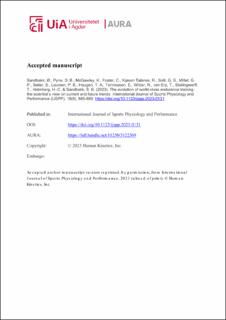| dc.contributor.author | Sandbakk, Øyvind Bucher | |
| dc.contributor.author | Pyne, David B. | |
| dc.contributor.author | McGawley, Kerry | |
| dc.contributor.author | Foster, Carl | |
| dc.contributor.author | Kjøsen Talsnes, Rune | |
| dc.contributor.author | Solli, Guro Strøm | |
| dc.contributor.author | Millet, Grégoire P | |
| dc.contributor.author | Seiler, Stephen | |
| dc.contributor.author | Laursen, Paul Byron | |
| dc.contributor.author | Haugen, Thomas André | |
| dc.contributor.author | Tønnessen, Espen | |
| dc.contributor.author | Wilber, Randy | |
| dc.contributor.author | van Erp, Teun | |
| dc.contributor.author | Stellingwerff, Trent | |
| dc.contributor.author | Holmberg, Hans-Christer | |
| dc.contributor.author | Sandbakk, Silvana Bucher | |
| dc.date.accessioned | 2024-03-14T10:06:58Z | |
| dc.date.available | 2024-03-14T10:06:58Z | |
| dc.date.created | 2023-08-29T12:25:30Z | |
| dc.date.issued | 2023 | |
| dc.identifier.citation | Sandbakk, Ø., Pyne, D. B., McGawley, K., Foster, C., Kjøsen Talsnes, R., Solli, G. S., Millet, G. P., Seiler, S., Laursen, P. B., Haugen, T. A., Tønnessen, E., Wilber, R., van Erp, T., Stellingwerff, T., Holmberg, H.-C. & Sandbakk, S. B. (2023). The evolution of world-class endurance training: the scientist’s view on current and future trends. International Journal of Sports Physiology and Performance (IJSPP), 18(8), 885-889. | en_US |
| dc.identifier.issn | 1555-0273 | |
| dc.identifier.uri | https://hdl.handle.net/11250/3122369 | |
| dc.description | Author's accepted manuscript | en_US |
| dc.description.abstract | Background: Elite sport is continuously evolving. World records keep falling and athletes from a longer list of countries are involved. Purpose: This commentary was designed to provide insights into present and future trends associated with world-class endurance training based on the perspectives, experience, and knowledge of an expert panel of 25 applied sport scientists. Results: The key drivers of development observed in the past 10–15 years were related to (1) more accessible scientific knowledge for coaches and athletes combined with (2) better integration of practical and scientific exchange across multidisciplinary perspectives within professionalized elite athlete support structures, as well as (3) utilization of new technological advances. Based on these perspectives, we discerned and exemplified the main trends in the practice of endurance sports into the following categories: better understanding of sport-specific demands; improved competition execution; larger, more specific, and more precise training loads; improved training quality; and a more professional and healthier lifestyle. The main areas expected to drive future improvements were associated with more extensive use of advanced technology for monitoring and prescribing training and recovery, more precise use of environmental and nutritional interventions, better understanding of athlete– equipment interactions, and greater emphasis on preventing injuries and illnesses. Conclusions: These expert insights can serve as a platform and inspiration to develop new hypotheses and ideas, encourage future collaboration between researchers and sport practitioners, and, perhaps most important, stimulate curiosity and further collaborative studies about the training, physiology, and performance of endurance athletes. | en_US |
| dc.language.iso | eng | en_US |
| dc.publisher | Human Kinetics | en_US |
| dc.title | The Evolution of World-Class Endurance Training: The Scientist's View on Current and Future Trends | en_US |
| dc.type | Peer reviewed | en_US |
| dc.type | Journal article | en_US |
| dc.description.version | acceptedVersion | en_US |
| dc.rights.holder | © 2023 Human Kinetics, Inc. | en_US |
| dc.subject.nsi | VDP::Medisinske Fag: 700::Idrettsmedisinske fag: 850 | en_US |
| dc.source.pagenumber | 885-889 | en_US |
| dc.source.volume | 18 | en_US |
| dc.source.journal | International Journal of Sports Physiology and Performance (IJSPP) | en_US |
| dc.source.issue | 8 | en_US |
| dc.identifier.doi | https://doi.org/10.1123/ijspp.2023-0131 | |
| dc.identifier.cristin | 2170555 | |
| cristin.qualitycode | 1 | |
